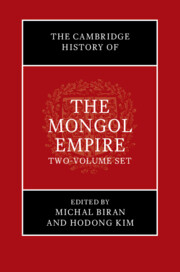Book contents
- The Cambridge History of the Mongol Empire
- The Cambridge History of the Mongol Empire
- Copyright page
- Dedication
- Contents
- Figures in Volume I
- Figures in Volume II
- Maps in Volume I
- Maps in Volume II
- Tables in Volume I
- Contributors to Volume I
- Contributors to Volume II
- Acknowledgments
- Notes on Dates and Transliterations
- Abbreviations
- Volume I
- Introduction
- Volume I Part 1 Political History
- 1 The Rise of Chinggis Khan and the United Empire, 1206–1260
- 2 The Empire of the Great Khan
- 3 The Ilkhanate, 1260–1335
- 4 The Golden Horde, c. 1260–1502
- 5 Mongol Central Asia
- Volume I Part 2 Thematic Histories
- Volume I Part 3 Views from the Edges
- Volume I Part 4 External Histories
- Epilogue
- Volume II
- Index to Volume I
- Index to Volume II
- References
5 - Mongol Central Asia
The Chaghadaids and the Ögödeids, 1260–1370
from Volume I Part 1 - Political History
Published online by Cambridge University Press: 01 January 2024
- The Cambridge History of the Mongol Empire
- The Cambridge History of the Mongol Empire
- Copyright page
- Dedication
- Contents
- Figures in Volume I
- Figures in Volume II
- Maps in Volume I
- Maps in Volume II
- Tables in Volume I
- Contributors to Volume I
- Contributors to Volume II
- Acknowledgments
- Notes on Dates and Transliterations
- Abbreviations
- Volume I
- Introduction
- Volume I Part 1 Political History
- 1 The Rise of Chinggis Khan and the United Empire, 1206–1260
- 2 The Empire of the Great Khan
- 3 The Ilkhanate, 1260–1335
- 4 The Golden Horde, c. 1260–1502
- 5 Mongol Central Asia
- Volume I Part 2 Thematic Histories
- Volume I Part 3 Views from the Edges
- Volume I Part 4 External Histories
- Epilogue
- Volume II
- Index to Volume I
- Index to Volume II
- References
Summary
This chapter outlines the history of Mongol Central Asia, known as the Chaghadaid Khanate, the least documented but most enduring of the Mongol successor states. Squeezed between the Chinggisid polities, lacking a strong sedentary basis, and home to two competing uluses, the Middle Mongolian Ulus, as the Mongols in Central Asia called themselves, was often plagued by warfare and suffered from “brain drain.” Yet it not only played a leading role in the dissolution of the Mongol Empire, but also introduced a political culture that impacted Central Asia up to the nineteenth century; contributed to the Islamization of eastern Central Asia; was the root of two of the most influential early modern empires, the Timurids and Mughals; and gave its name, Chaghatay, to the Eastern Turkic language. The chapter discusses its political history during the Mongol moment, and briefly reviews its postimperial history and aspects of economy, administration, and culture.
Keywords
- Type
- Chapter
- Information
- The Cambridge History of the Mongol Empire , pp. 319 - 396Publisher: Cambridge University PressPrint publication year: 2023
References
- 1
- Cited by

